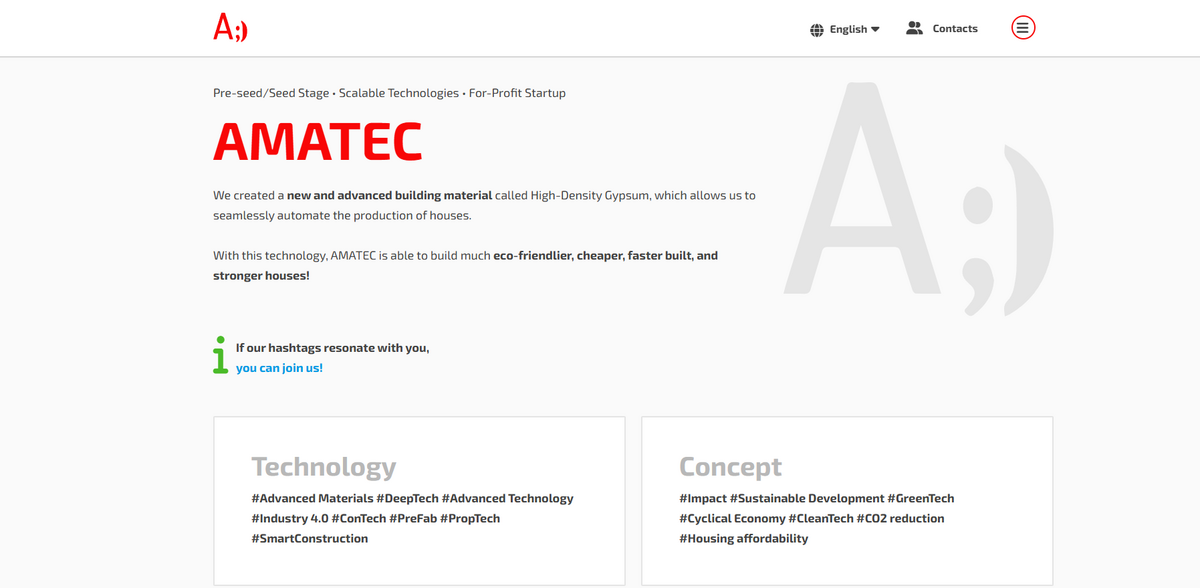What is the AMATEC Project?
AMATEC has introduced a revolutionary building material known as High-Density Gypsum that automates the production of houses seamlessly. This material is advanced, eco-friendly, and outperforms traditional options while being cheaper, faster built, and stronger. High-density gypsum is a radical evolution from conventional structural materials such as concrete, wood, masonry, and steel – the so-called Big 4 that have dominated the construction industry for decades. This breakthrough technology dramatically increases the density of standard gypsum by 1.5–2 times, turning it into a proper competitor to those older materials.
Main Benefit
AMATEC’s innovative approach brings many benefits that are reshaping construction. Key figures and facts include:
- High-Speed Manufacturing – A kit for a 1,300 square foot house can be produced within 12–16 hours on a single line of production.
- 20–140% Increase in Productivity – Elevated automation reduces manual labor significantly, cutting labor costs by up to tenfold.
- 30%+ Cheaper – Lower production expenses due to the unique nature of high-density gypsum.
- Cures over 80% faster than Portland cement concrete – reaching 3,000 psi+ in strength within 2 hours compared to a few days for traditional concrete.
- Carbon footprint is approximately 3 times lower – elimination of cement, the main culprit behind concrete’s enormous carbon emissions.
Addressing Construction Industry Challenges
The modern construction industry has long struggled with several issues. Among the most pressing problems is the housing crisis – even highly developed countries face a significant shortage of homes. For instance, the US saw a housing deficit jump from 3.84 million in 2019 to 5.24 million in 2022. Skyrocketing prices of the traditional materials only add insult to injury, compounded by a decline in labor productivity and a shortage of skilled workers. Moreover, today’s materials suffer from deterioration; more than 50% of housing stock experiences complete physical decay. The fact that nearly 89% of these materials are non-recyclable further emphasizes the need for sustainable alternatives.
Innovation in Gypsum Technology
The innovation behind high-density gypsum is nothing short of remarkable. Conventional gypsum was never considered for use as the primary structural support in buildings because of its low density compared to materials like concrete. However, by drastically increasing the density, AMATEC’s technology has turned the tables – now high-density gypsum can outperform ordinary concrete in strength. Its fast curing ability is a game-changer: within just 20–30 minutes the material hardens, and its rapid strength gain (10–100 times faster than concrete) makes it a formidable competitor against legacy building materials. The fluid consistency enables it to flood molds seamlessly without issues such as shrinkage-induced deformations, and since it requires no drying process after manufacturing, efficiency is further boosted.
Business Model Snapshot
AMATEC’s strategy includes a direct-to-consumer (D2C) model that upends the traditional, time-consuming process of constructing houses. The project bypasses the conventional channel by delivering a custom-made, ready-to-assemble house set directly to customers. Investing in advanced material technology and state-of-the-art manufacturing—complemented by high-performing software—AMATEC is poised to scale quickly in an unsatisfied market. This approach not only eliminates the quarters’ excessive reliance on manual labor but also reduces production costs dramatically.
Historical and Environmental Impact
Interestingly, gypsum isn’t a new discovery in the realm of construction. In the former USSR, hundreds of thousands of buildings were constructed with gypsum starting as far back as the 1940s. An inspection in the late twentieth century confirmed that, under specific conditions, gypsum works reliably as a primary structural material. These enduring structures, which have withstood diverse and harsh climates, are living proof of gypsum’s longevity and reliability. In today’s world, high-density gypsum also addresses critical sustainability challenges. While modern construction methods contribute to over 17% of global CO₂ emissions, high-density gypsum production consumes much less energy, emits significantly lower CO₂ (a factor 10 lower than cement production), and is fully recyclable. Essentially, each gypsum house built contributes to a tangible reduction in carbon emissions by a factor of 3 to 5 per square foot.
Project Impact
- SDG 9: Industry, Innovation and Infrastructure – Pioneering materials that redefine construction parameters.
- SDG 11: Sustainable Cities and Communities – Delivering affordable, fast-built housing solutions that address supply gaps.
- SDG 13: Climate Action – Dramatically lowering carbon emissions and fostering a circular economy through recyclable building materials.
Future Outlook and Growth
The AMATEC project stands at the convergence of cutting-edge material science and the pressing needs of modern society. With the upcoming pilot project that will see the assembly of their first demo house in 2022, there is an expectation of exponential growth. This technology is set to transform offsite and prefab housing markets by eliminating components such as 2x4s, drywall, air/vapor membranes, OSB, and even cement in foundations. The elimination of these elements simplifies the construction process, reduces time significantly, and ensures cost-effectiveness. In a dynamic, ever-evolving industry marked by housing shortages and unreliable traditional materials, AMATEC’s new high-density gypsum technology offers a breath of fresh air… an innovative solution that promises a sustainable, robust future for construction.





















